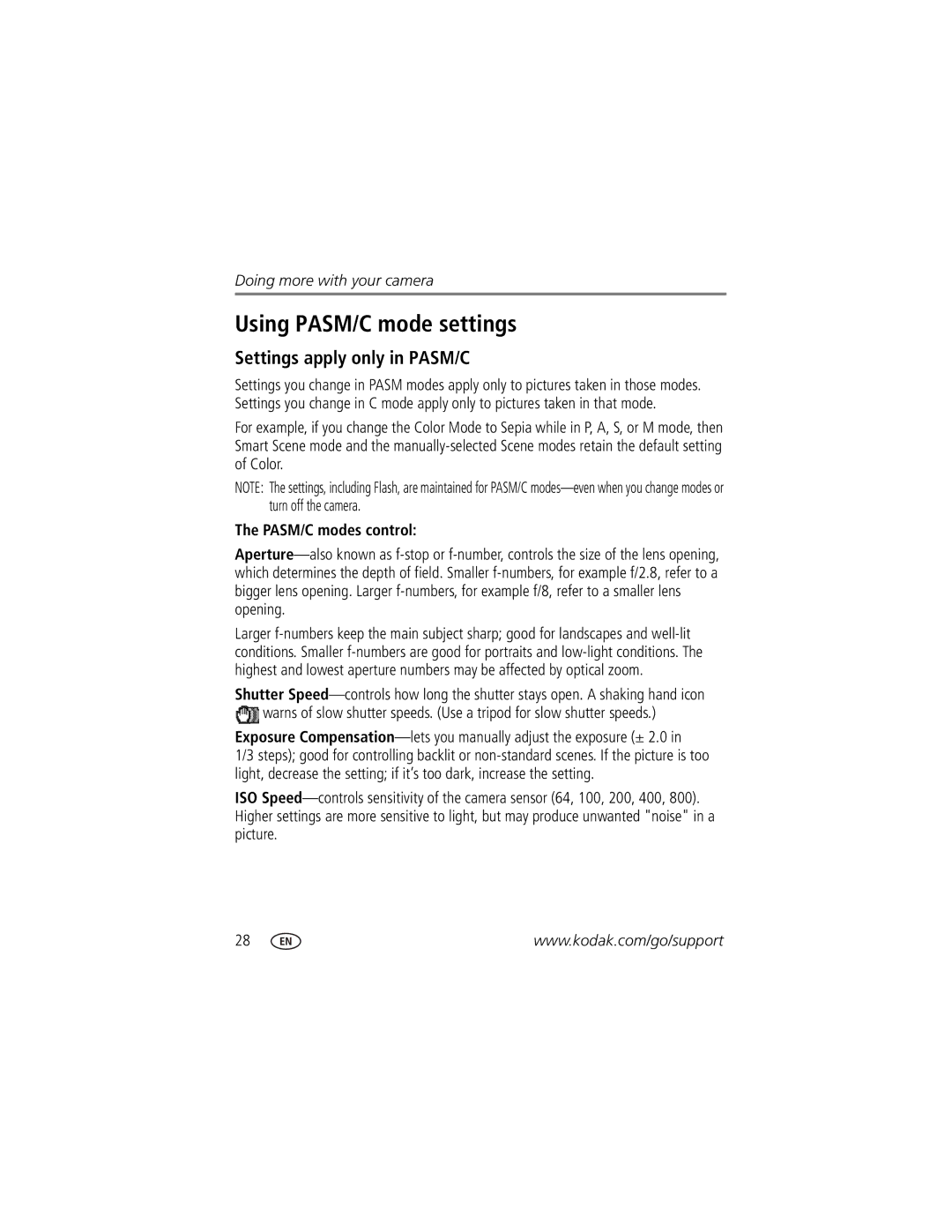Kodak EasyShare C875 zoom digital camera User’s guide
Eastman Kodak Company Rochester, New York
Front view
Shutter button Speaker Mode dial Flash Power light
Flash button Lens
Back view
Table of contents
Table of contents
Installing the software
Attaching the strap
Install other batteries as shown
Loading the battery
If your package includes a battery charger
If your package does not include a charger or dock
Turning on the camera
If your package includes an EasyShare dock
Setting the language, date/time first time
Setting the language, date/time other times
Storing pictures on an SD or MMC card
Taking a picture
Histogram is accessible only in PASM/C modes
Taking a video
Picture blur warning icon is displayed during quickview
Reviewing the picture or video just taken
Understanding quickview blur warning icons
White-Printability is still being determined
Smart Scene mode -shutter pressed halfway
Understanding picture-taking icons
Manual mode PASM/C-no buttons pressed
Manual mode PASM/C-shutter pressed halfway
Using the auto-focus framing marks to take pictures
Press the Shutter button completely down to take the picture
Reviewing pictures and videos on your camera
View and work with your pictures and videos in Review mode
Magnifying a picture during review
Pictures
Understanding review icons
Videos
Protecting pictures and videos from deletion
Using the undo delete feature
Deleting pictures and videos during review
Press the Menu button to exit the menu
Follow the on-screen instructions to install the software
Transferring and printing pictures
Transferring pictures
Also available for transferring
Printing pictures
Connecting the camera to a PictBridge enabled printer
Turn off the camera and printer
Printing from a PictBridge enabled printer
Using a printer that is not PictBridge enabled
Disconnecting the camera from a PictBridge enabled printer
Ordering prints online
Printing from an optional SD/MMC card
Custom
Kodak EasyShare dock Docking configuration
Dock compatibility for your camera
Dock
Take the picture or video
Using optical zoom
Using digital zoom
Take the picture
Using the flash
Picture-taking modes
Shutter
Use this mode For
Aperture Priority
Manual
Press the OK button to choose a Scene mode
Turn the Mode dial to Scene
Scene modes
Museum Self
Using the framing grid to compose a picture
Use this For SCN mode Manner
Panning
Taking panoramic pictures
Take the first picture
Using the histogram to view picture brightness
Press until the histogram appears
Settings apply only in PASM/C
Using PASM/C mode settings
PASM/C modes control
Changing PASM/C mode settings
Take a picture
Using the self-timer
Use the same procedure to take a video, but
Using burst
Press the Shutter button halfway to focus and set exposure
Using camera Help
Changing picture-taking settings
Exposure Metering
Landscape mode
Setting Options White Balance
Focus Zone
Black-and-white or sepia
Setting Options AF Control
Unavailable in Video mode
Press the Shutter button halfway down to focus
Location
Auto Power Off Minutes
Setting Options Return to previous menu Camera Sounds
High Power
Turns off Minutes default Date & Time
Is set to Off
Formatting deletes all
Running a slide show
Starting the slide show
Removing a card during
Displaying pictures and videos on a television
Changing the slide show display interval
Running a continuous slide show loop
Press to highlight On, then press the OK button
Press the Review button, then to find a picture to crop
Using Kodak Perfect Touch technology
Cropping pictures
Press Telephoto T to zoom in, or
Making a video action print
Editing videos
Trimming a video
You can do incredible things with your videos
Viewing picture/video information
Viewing pictures/videos in different ways
Viewing by date or by album
Viewing as thumbnails multi-up
Before you copy, make sure that
Selecting multiple pictures/videos
Copying pictures and videos
Card is inserted in the camera
Second-on your camera
Pre-tagging for album names
First-on your computer
Third-transfer to your computer
Tagging pictures/videos for albums
Tagging pictures for printing
Sharing your pictures
Printing tagged pictures
Second-tag pictures/videos on your camera
Tagging pictures and videos for emailing
First-on your computer
Third-transfer and email
Pictures to your
Tagging pictures as favorites
Transfer
Computer
Removing all favorites from your camera
Optional settings
Preventing favorites from transferring to the camera
Printing and emailing favorites
Interactive Troubleshooting & Repairs
Camera problems
Status Possible solution
Status Possible solution
Computer/connectivity problems
Picture quality problems
Subject
Adjust exposure compensation
Reposition camera for more available light
Effective flash range
Camera ready-light status
Direct printing PictBridge enabled printer problems
Helpful links
Camera
Processor type and speed MHz
Telephone customer support
Camera serial number
Disk space
Kodak EasyShare C875 zoom digital camera
Camera specifications
MP 1200 x 900 pixels
Displays
Flash
Exposure
Capture
Review
Power
Other features
Communication with computer/TV
Picture storage capacity-standard compression
Storage capacities
Video storage capacity
Using this product
Important safety instructions
Battery safety and handling
When removing the battery, allow it to cool it may be hot
Battery life
CRV3 lithium battery AA 2 lithium batteries
Extending battery life
Limited warranty coverage
Warranty
Limited warranty
Limitations
Your rights
FCC compliance and advisory
Regulatory compliance
Outside the United States and Canada
Kodak EasyShare C875 zoom digital camera
Australian C-Tick
Canadian DOC statement
Vcci Class B ITE
MPEG-4
Index
Beach
Index
Histogram
About pictures, videos, 43 installing
LCD/info/help button, ii, 6 lens Cleaning lens, 66 light
Blur, 7 icons
Manual
Program mode Protecting pictures, videos
Using Ready light
Text
Inserting, 5 printing from, 18 slot
Self-timer delay
SCN, 22 SD/MMC card
Shutter button
Television, slide show, 40 text Time, setting
Snow, 24 software
Windows OS-based computers installing software

![]() warns of slow shutter speeds. (Use a tripod for slow shutter speeds.)
warns of slow shutter speeds. (Use a tripod for slow shutter speeds.)